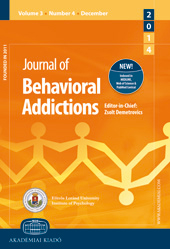Social influences normalize gambling-related harm among higher risk gamblers
Social influences normalize gambling-related harm among higher risk gamblers
Author(s): Alex M.T. Russell, Erika Lingham, Nerilee HingSubject(s): Behaviorism
Published by: Akadémiai Kiadó
Keywords: gambling; social network analysis; egocentric social network analysis; normalization; harm; influence
Summary/Abstract: Social influences are key drivers of gambling, and can begin in youth through parental modeling and facilitation. Over time, social influence from friends and colleagues also becomes important. Social network analysis provides a method to measure the combined nature of these social influences. This study aimed to compare social influences across gambling risk groups, by examining key characteristics of the social networks, among Australian adults. Methods. A total of 784 respondents (egos) reported their demographics, gambling behavior and gambling risk, as well as those of the 20 most influential people in their lives (alters). Egos also reported the strength of the connection between themselves and each of their alters, and between each pair of alters. Data were analyzed using egocentric social network analysis approaches. Results. Egos in higher risk groups reported more alters who gamble, including a higher proportion experiencing gambling-related harm. Relationship strength indicated that egos in higher risk groups tended to feel closer to their alters, regardless of whether the alter gambles or not. Network density (interconnectedness between alters) was greater for egos in higher risk groups. Discussion and conclusions. The findings indicate that both gambling behavior and gambling-related harm are normalized through social connections. Greater interconnectedness in the networks of higher risk gamblers indicates difficulties in reducing or removing these influences. The findings indicate limitations of individualised interventions, and instead highlight the important role of changing norms within society, which can be transmitted throughout these networks.
Journal: Journal of Behavioral Addictions
- Issue Year: 7/2018
- Issue No: 4
- Page Range: 1100-1111
- Page Count: 12
- Language: English

